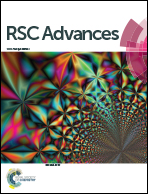Novolac-based poly(1,2,3-triazolium)s with good ionic conductivity and enhanced CO2 permeation†
Abstract
Novolac-based poly(1,2,3-triazolium)s with 1,2,3-triazolium side groups spaced by oligo(ethylene glycol), a new kind of poly(ionic liquid) membrane, was prepared via the well-known Click chemistry (1,3-dipolar cycloaddition reaction). The thermal properties, ionic conductivity and gas permeation performance of these self-standing membranes were investigated. The obtained membranes exhibit glass transition temperatures ranging from −1 °C to −7.5 °C, and a temperature at 10% weight loss above 330 °C. These membranes have good ionic conductivity (σDC up to 5.1 × 10−7 S cm−1 at 30 °C under anhydrous conditions) as compared with the reported 1,2,3-triazolium-based crosslinked polymers. And they could be potentially used for CO2 separation as they exhibit enhanced CO2 permeability up to 434.5 barrer at 4 atm pressure.



 Please wait while we load your content...
Please wait while we load your content...